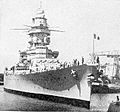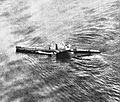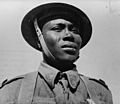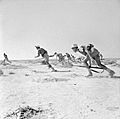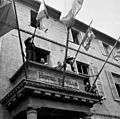Free France facts for kids
Free France and its Free French Forces (in French: France Libre and Forces françaises libres) were the government-in-exile led by Charles de Gaulle during World War II. These were the French military forces that kept fighting against the Axis powers as one of the Allies. This happened after France was defeated in the Battle of France.
Free France was set up in London in June 1940. It also helped organize and support the Resistance movement inside occupied France.
Charles de Gaulle was a French government minister. He disagreed with the agreement to stop fighting (called an armistice) that Marshal Philippe Pétain had made. De Gaulle escaped to Britain and spoke on BBC radio in his famous "Appeal of 18 June" (Appel du 18 juin). He urged all French people to keep resisting. This speech greatly boosted morale across France and its colonies. However, only a small number of French forces joined de Gaulle at first.
Contents
What Was Free France?
Free France was like a temporary government for France while the country was occupied. It was based outside of France and worked to free the country from enemy control. Its main goal was to continue the fight against Germany and its allies.
Charles de Gaulle's Call to Action
After France was defeated in 1940, many people felt hopeless. Charles de Gaulle believed that France should not give up. He made a powerful radio speech from London, telling the French people to continue the fight. This speech became a symbol of hope and resistance.
Organizing the Resistance
To help organize the fight, the Empire Defense Council (Conseil de défense de l'Empire) was created on 27 October 1940. This council helped manage the French territories in Africa, Asia, and Oceania that had joined de Gaulle.
From Free France to Fighting France
Later, on 24 September 1941, the Empire Defense Council was replaced by the French National Committee (Comité national français or CNF). This new group helped lead the Free French movement. On 13 July 1942, "Free France" was officially renamed France combattante ("Fighting France"). This new name showed that the fight against the Axis powers was happening both outside France by the Free French Forces and inside France by the French Forces of the Interior (FFI).
Uniting the French Forces
After the Allies took back North Africa, Fighting France joined forces with General Henri Giraud's command in Algiers. They formed the French Committee of National Liberation (Comité français de Libération nationale or CFNL). This group became the main French authority fighting the Axis.
The time of exile officially ended when the 2nd Armoured Free French Division and Resistance forces captured Paris on 25 August 1944. This led to the creation of the Provisional Government of the French Republic (gouvernement provisoire de la République française or GPRF). This government ruled France until the end of the war and until 1946. In 1946, the Fourth Republic was established, ending the temporary governments that followed the fall of the Third Republic in 1940.
Where Did They Fight?
The Free French fought against both Axis and Vichy regime troops. Vichy France was the French government that cooperated with Germany during the war. Free French soldiers fought on many battlefronts, from the Middle East to Indochina and North Africa.
The Free French Navy worked closely with the Royal Navy (British Navy). In the North Atlantic, they also helped the Royal Canadian Navy. Free French soldiers also served in the Royal Air Force (British Air Force), the Soviet Air Force, and the British SAS. Later, larger French commands were set up directly under the control of the government-in-exile.
Taking Back French Territories
From their bases in French colonies in Africa, India, and the Pacific, Free France slowly took control of more and more territories that had been under Vichy rule. After the Allied landings in North Africa (Operation Torch) in November 1942, Vichy France only controlled the zone libre (unoccupied zone) in southern France and a few places in the West Indies. They also nominally controlled Japanese-occupied French Indochina.
The French Army of Africa then switched its loyalty to Free France. Because of this, the Axis powers decided to occupy Vichy France in reaction.
The Army Grows Stronger
On 1 August 1943, the L'Armée d'Afrique (Army of Africa) officially joined with the Free French Forces. They formed L'Armée française de la Liberation (The French Army of Liberation). By mid-1944, this army had more than 400,000 soldiers. They took part in the Normandy landings and the invasion of southern France. They eventually led the push to liberate Paris.
Soon, they were fighting in Alsace, the Alps, and Brittany. By the end of the war in Europe, they had grown to 1,300,000 soldiers. This made them the fourth-largest Allied army in Europe. They played a key role in the Allied advance through France and the invasion of Germany.
The End of the War and Beyond
After France was liberated, the Free French government set up a temporary republic. This prepared the way for the Fourth Republic, which was established in 1946. Free France played a vital role in ensuring France's place among the victorious Allied nations.
Images for kids
-
Charles de Gaulle was an armoured division commander and a minister in the Reynaud government during the Battle of France.
-
In Occupied France during the war, reproductions of the 18 June appeal were distributed through underground means as pamphlets and plastered on walls as posters by supporters of the Résistance. This could be a dangerous activity.
-
Emile Fayolle, pilot of the Free French Air Force, during the Battle of Britain
-
A very modern Dunkerque-class battleship commissioned in 1937, Strasbourg was potentially a quite substantial threat to British control of the sealanes were she to fall into Axis hands.
-
Insigna of the Free French Forces in the Far East (French Indochina), Langlade Mission
-
The fall of Damascus to the Allies, late June 1941. A car carrying Free French commanders General Georges Catroux and General Paul Louis Le Gentilhomme enters the city, escorted by French Circassian cavalry (Gardes Tcherkess).
-
The FFF's tenacious defence at Bir Hakeim prevented Rommel's attempted flanking manoeuvre at El Alamein from succeeding.
-
Operation Torch landings in Morocco and Algeria
-
Henri Giraud and de Gaulle during the Casablanca Conference in January 1943. Churchill and Roosevelt are in the background.
-
FAFL Normandie-Niemen Yak-3 preserved at the Paris Le Bourget museum
-
Charles de Gaulle speaks as president of interim government to the population of Cherbourg from the city hall's balcony on 20 August 1944
-
The Western Front in 1944
-
Leclerc's 2nd Armoured Division (2e DB) parading down the Champs Elysées on 26 August 1944, the day after the Liberation of Paris
-
A plaque commemorating the Oath of Kufra in near the cathedral of Strasbourg
See also
 In Spanish: Francia Libre para niños
In Spanish: Francia Libre para niños







